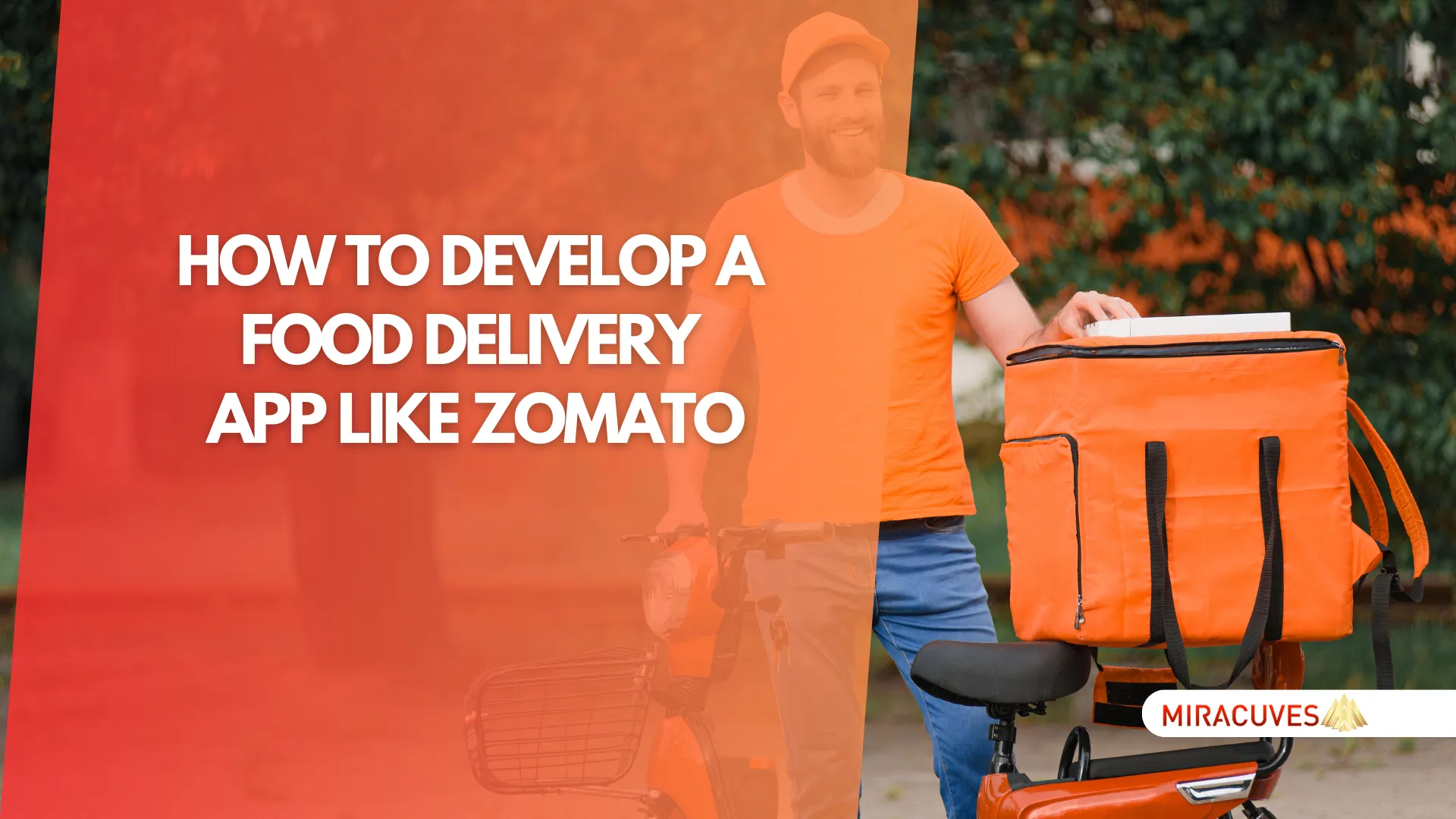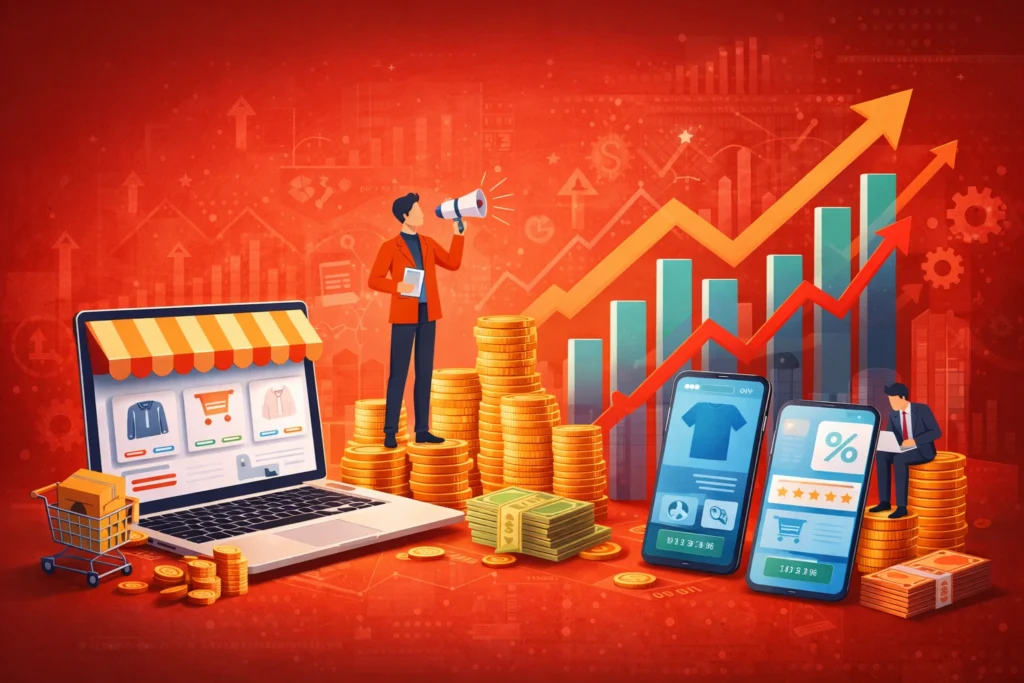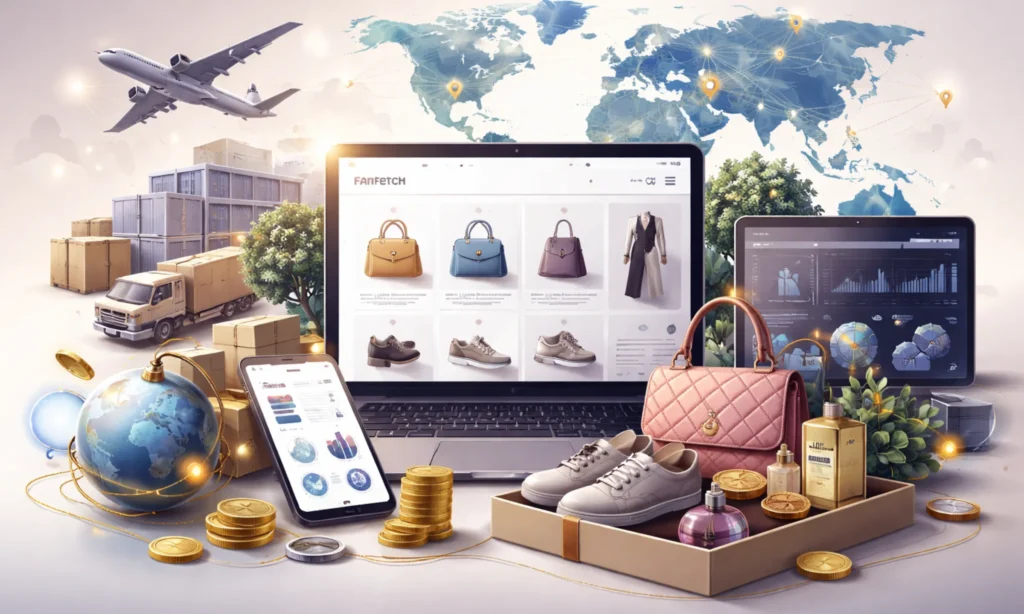In today’s fast-paced world, food delivery apps have become an integral part of our daily lives, revolutionizing the way people order and enjoy meals. Among these apps, Zomato has emerged as a dominant player, providing users with easy access to thousands of restaurants and offering seamless delivery experiences. The growing demand for convenient food ordering has led to a surge in businesses wanting to replicate the success of platforms like Zomato, making it an attractive venture for entrepreneurs and developers alike.
Building a food delivery app like Zomato offers immense opportunities in the booming on-demand food service industry. By leveraging the right features and technologies, you can create a robust app that caters to both customers and restaurants. With companies like Miracuves Solutions, developing a Zomato-like app has never been easier or more cost-effective. Miracuves offers pre-designed templates that drastically cut down on development time and cost, making it accessible even for small businesses.
In this guide, we will explore the features, costs, and timeline for developing a food delivery app like Zomato, offering insights into how to succeed in this competitive market.
What is Zomato and What Does It Do?
Zomato is a globally recognized food delivery and restaurant discovery platform that has transformed how people order food and explore dining options. Initially launched as a restaurant discovery app, Zomato quickly evolved into a full-fledged food delivery service, offering users the convenience of ordering from a wide range of restaurants with just a few taps on their smartphones.
The app’s core functions include:
- Restaurant Listings: Zomato provides comprehensive information about restaurants, including menus, user reviews, ratings, and photos, helping users make informed dining choices.
- Online Food Ordering: One of the app’s most popular features is its food delivery service, allowing customers to order meals directly from partner restaurants, track their orders in real-time, and pay through various payment gateways.
- User Reviews and Ratings: Zomato enables users to leave reviews and rate restaurants based on their experiences, creating a community-driven platform that helps guide others in choosing where to eat.
- Restaurant Integration: For restaurant owners, Zomato offers a platform to reach new customers, manage deliveries, and gain valuable insights through in-app analytics.
By combining user-friendly features with a seamless interface, Zomato has successfully built a bridge between restaurants and consumers, becoming a go-to app for millions around the world.
Why Build a Food Delivery App Like Zomato?
The demand for food delivery services has skyrocketed in recent years, with more consumers opting for the convenience of ordering meals online. Apps like Zomato have capitalized on this trend by offering an all-in-one solution for browsing restaurants, placing orders, and tracking deliveries—all from a single platform. With the on-demand food delivery industry projected to grow exponentially, building a food delivery app like Zomato presents a lucrative opportunity for businesses.
There are several compelling reasons to build an app like Zomato:
- Rising Consumer Demand: In today’s fast-paced world, consumers prioritize convenience. A food delivery app offers exactly that, making it easier for people to enjoy their favorite meals without leaving their homes. With the shift toward online food ordering, this trend shows no signs of slowing down.
- Profitable Revenue Models: Food delivery apps like Zomato use multiple revenue streams, including delivery fees, commissions from partner restaurants, and even advertising space within the app. This diversification allows for steady income, making it a sustainable business model.
- Market Expansion Opportunities: Building a food delivery app opens the door for expanding into multiple verticals like grocery delivery, cloud kitchens, and meal subscriptions. It’s not just about food anymore; the same technology can be applied to various on-demand services.
By tapping into this growing industry, you can cater to the needs of modern consumers and establish a profitable business. Whether you’re a startup or an established business, creating a food delivery app can help you reach new customers and grow your brand.
Market Size, Growth, and Revenue Model
| Revenue Model | Zomato | Uber Eats | DoorDash |
|---|---|---|---|
| Delivery Fees | Variable based on distance and order value | Flat fee or distance-based | Flat fee plus dynamic pricing |
| Commissions | 20-30% per order | 15-30% per order | 15-25% per order |
| Advertising | Paid restaurant listings | Paid restaurant listings | Paid restaurant listings |
| Subscription Services | Zomato Gold (free delivery, discounts) | Uber Pass (discounts on delivery fees) | DashPass (free delivery, reduced fees) |
| Additional Revenue Streams | Premium features, event partnerships | Partnerships with local restaurants | Partnerships with local restaurants, logistics services |
The global food delivery market has experienced massive growth in recent years, driven by changes in consumer behavior and advancements in technology. According to recent studies, the online food delivery industry is expected to reach $320 billion by 2029, showcasing the incredible potential this market holds for new entrants. Building a food delivery app like Zomato allows businesses to tap into this rapidly expanding industry and take advantage of its various revenue models.
Market Size and Growth
The rise of on-demand services has reshaped how consumers interact with food businesses. As of 2023, the global online food delivery market is valued at over $150 billion and continues to grow at a compound annual growth rate (CAGR) of 10-12%. This growth is fueled by urbanization, the increasing availability of high-speed internet, and changing consumer preferences, especially among younger generations who value convenience.
Revenue Model
There are several revenue streams available when developing a food delivery app:
- Delivery Fees: Customers are charged a fee for each delivery, which can be adjusted based on distance or order value.
- Commissions: The app earns a percentage of each order made through its platform from partner restaurants. Zomato typically charges around 20-30% commission, making this a substantial income source.
- Advertising: Restaurants can pay for premium placement on the app, increasing their visibility to users. This advertising model provides an additional stream of revenue.
- Subscription Services: Zomato offers a subscription model called Zomato Gold, which gives customers benefits like free delivery or discounts. Subscriptions provide steady, recurring income.
By leveraging these revenue models, businesses can create a sustainable and profitable food delivery platform.
Read More “Create a Food Delivery App Like Swiggy: Key Features, Cost, and Development Process“
How to Differentiate Your Food Delivery App from Zomato?
Building a food delivery app like Zomato is a great start, but to succeed in a competitive market, you’ll need to set your app apart with unique features and services. Simply copying the basic model won’t be enough to stand out. By incorporating innovative ideas and focusing on customer needs, you can create an app that offers something fresh while still delivering the convenience that users expect.
Here are several key strategies to differentiate your app:
1. Niche Market Focus
- While Zomato caters to a broad audience, targeting a niche can help you capture a dedicated user base. For example, you can focus on delivering healthy meals, local delicacies, or gourmet experiences. By narrowing your focus, you attract customers with specific preferences that mainstream apps may not cater to.
2. Unique Features
- Incorporating AI-powered recommendations or personalized meal plans can make your app more engaging. Other features like real-time health data tracking (e.g., calories or allergens) or offering an eco-friendly delivery option (using bicycles or electric vehicles) could appeal to health-conscious or environmentally aware consumers.
3. Local Partnerships and Exclusivity
- One of the best ways to differentiate is by partnering with local, exclusive restaurants that aren’t available on Zomato. Offering delivery for smaller, high-quality eateries can give your app a unique edge and attract food lovers looking for something special.
4. Better Delivery Experience
- You can enhance the delivery experience by providing faster delivery times, offering options like contactless delivery, or providing detailed information about the delivery driver (background checks, ratings, etc.). These added touches will improve customer trust and loyalty.
5. Customer Loyalty Programs
- Offering innovative loyalty programs, such as points-based systems or referral bonuses, can help retain users. By rewarding users for frequent orders, your app can build long-term relationships with customers.
Key Features of a Zomato-like App
| Feature | Zomato | Uber Eats | GrubHub |
|---|---|---|---|
| User Profiles and Authentication | Yes (Social media, Google login) | Yes (Google, Facebook) | Yes (Email, Social media) |
| Restaurant Listings and Filters | Extensive listings with filters (cuisine, price, location) | Extensive listings with filters (delivery time, cost) | Comprehensive listings with filters (ratings, cuisine) |
| Real-time Order Tracking | Yes (Real-time GPS tracking) | Yes (Real-time tracking) | Yes (Real-time tracking available) |
| Multiple Payment Options | Credit/Debit cards, digital wallets, COD | Credit/Debit cards, PayPal, digital wallets | Credit/Debit cards, PayPal, digital wallets, COD |
| Ratings and Reviews | Yes (Verified reviews, ratings) | Yes (Ratings for restaurants and delivery) | Yes (User reviews and ratings) |
| Push Notifications | Yes (Order status, deals, restaurant updates) | Yes (Order status, promotions) | Yes (Order status, promotions) |
| Restaurant/Delivery Dashboards | Yes (Manage orders, menus, reviews) | Yes (Restaurant and delivery dashboards) | Yes (Manage orders, delivery routes) |
To build a successful food delivery app like Zomato, it’s essential to integrate key features that enhance the user experience for both customers and restaurants. These features are not just about convenience; they are what make the platform attractive, functional, and scalable. Below are the essential components that should be included in any food delivery app:
1. User Profiles and Authentication
- Users need a simple and secure way to sign up and log in. Features like social media integration or Google login make it easy for users to create accounts. Profiles should store delivery addresses, preferences, and order history to streamline the user experience.
2. Restaurant Listings and Filters
- A comprehensive list of restaurants, categorized by cuisine, price, or location, is crucial. Implement filters for quick sorting, allowing users to find exactly what they want. Geo-location-based suggestions can enhance this experience by showing nearby restaurants.
3. Real-time Order Tracking
- One of Zomato’s standout features is the ability to track orders in real-time. This builds transparency and keeps users engaged from the moment the food is prepared until it arrives at their doorstep. Integration of GPS and mapping services is essential for this.
4. Multiple Payment Options
- Offering diverse payment options is key. Users should be able to pay using credit cards, debit cards, digital wallets like PayPal, or even cash on delivery. Secure payment gateways are non-negotiable to ensure user trust.
5. Ratings and Reviews
- User-generated content in the form of reviews and ratings helps build trust in the platform. This feature allows customers to leave feedback about restaurants, helping others make informed decisions. Verified reviews can add credibility.
6. Push Notifications
- Push notifications are essential for keeping users engaged. From informing them about new restaurant partners, exclusive deals, to updating them about their order status, timely notifications improve customer retention and interaction.
7. Restaurant and Delivery Partner Dashboards
- Restaurants need a back-end dashboard to manage incoming orders, update menus, and monitor reviews. Similarly, delivery personnel should have a simple interface to manage their deliveries and routes.
By integrating these key features, your app can offer a user-friendly and efficient experience that keeps customers coming back for more.
Minimum Viable Product (MVP) for a Food Delivery App
Launching a Minimum Viable Product (MVP) is a smart way to test your food delivery app in the market without the risk of over-investing in unnecessary features. An MVP version of your app includes only the core features necessary to attract early adopters, gain feedback, and validate your business model. Once the MVP gains traction, you can add more advanced features based on user feedback and market demand.
Here are the essential features to include in an MVP for a food delivery app like Zomato:
1. User Registration and Login
- A simple registration system allowing users to create an account using email, social media, or Google login. This feature is vital for tracking orders and personalizing the experience.
2. Restaurant Listings
- The MVP should have a basic restaurant catalog that includes key details like name, cuisine type, delivery hours, and basic pricing. Initially, you can partner with a few local restaurants to test the platform’s functionality.
3. Order Placement and Checkout
- Allow users to select menu items, add them to their cart, and place orders. Include a basic checkout process with support for a couple of payment methods like credit/debit cards and cash on delivery.
4. Delivery Tracking
- Even at the MVP stage, users expect to know the status of their order. A simplified version of real-time order tracking is crucial. This feature can evolve over time but should initially offer users estimated delivery times.
5. Ratings and Reviews
- A simple system for users to rate their food and delivery experience. This feature builds trust among future users and provides insights for both restaurants and the app developer.
Launching with just these essential features allows you to enter the market quickly and start collecting real user feedback. By focusing on the core elements, you can minimize development time and cost while providing enough functionality for a successful app launch.
Read More “Types of Food Delivery App and the Secret to Their Success“
Ready to start your own food delivery app like Zomato?
Our team of experts can help you create a seamless platform
for food discovery, ordering, and delivery.
Technical Requirements for Building a Zomato-like App
| Component | Option 1 (Cost-Effective) | Option 2 (Scalable & Robust) | Option 3 (Flexible & Fast) |
|---|---|---|---|
| Backend | Node.js | Python (Django) | Ruby on Rails |
| Frontend | React Native (Cross-platform) | Flutter (Cross-platform) | Native iOS (Swift) & Android (Kotlin) |
| Database | MySQL (Relational) | PostgreSQL (Relational) | MongoDB (NoSQL) |
| Real-time Features | Google Maps API | Mapbox API | OpenStreetMap API |
| Payment Gateway | Stripe | PayPal | Braintree |
| Cloud Hosting | AWS (Amazon Web Services) | Google Cloud | Microsoft Azure |
Developing a food delivery app like Zomato requires a solid technical foundation to ensure smooth performance, scalability, and security. The right technology stack will not only power the app but also help it handle a growing user base and the complex operations of food delivery, such as real-time tracking, payment processing, and restaurant management. Below are the core technical requirements for building a robust food delivery platform:
1. Backend Development
- The backend is the brain of your app, handling server-side operations like user management, order processing, and communication with restaurants. Technologies such as Node.js or Python (Django) are popular for backend development because they offer high performance and scalability. You also need a RESTful API to connect the backend to the app’s frontend.
2. Frontend Development
- The frontend is the face of your app, where users interact with the platform. For mobile app development, using cross-platform frameworks like React Native or Flutter is highly recommended. These frameworks allow you to build apps for both iOS and Android with a single codebase, reducing development time and cost.
3. Database Management
- A fast and reliable database is essential for storing and managing user data, restaurant information, menus, and orders. MySQL and PostgreSQL are great options for relational databases, while MongoDB can be used for more flexible, unstructured data management.
4. Real-time Features
- Real-time GPS tracking is crucial for both customers and delivery drivers. Implementing Google Maps API or Mapbox will enable you to track deliveries in real time. Similarly, you can use WebSockets to ensure real-time communication between the user, restaurant, and delivery personnel.
5. Payment Gateway Integration
- Secure payment processing is a key feature for any food delivery app. Integrating reliable payment gateways like Stripe, PayPal, or local solutions ensures that users can pay safely and quickly. These gateways come with built-in security features like encryption and fraud detection, which are essential for user trust.
6. Cloud Storage and Hosting
- Hosting your app on a cloud platform like Amazon Web Services (AWS) or Google Cloud ensures high scalability and availability. As your user base grows, cloud solutions can easily expand to handle increased traffic and data without compromising performance.
By selecting the right technology stack, you can build a food delivery app that is not only efficient but also scalable, secure, and user-friendly.
Design and User Interface
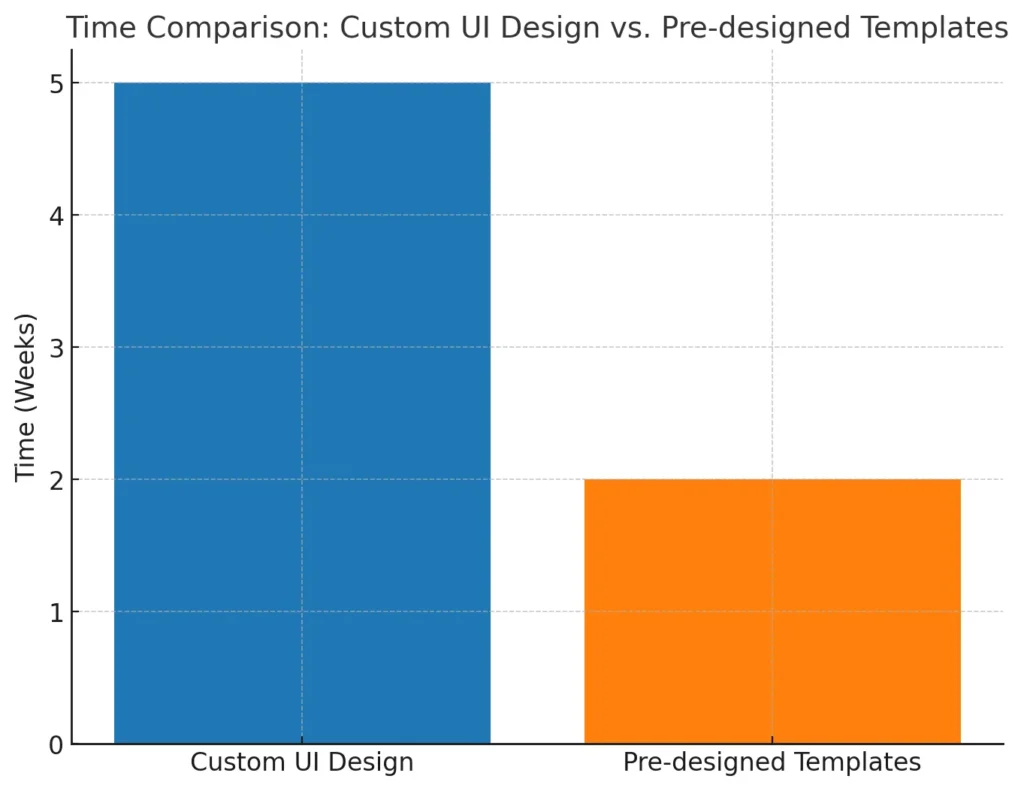
The design and user interface (UI) of a food delivery app plays a crucial role in its success. A well-designed app not only looks appealing but also provides a seamless user experience (UX), making it easy for customers to browse restaurants, place orders, and track their deliveries. In a highly competitive market, where apps like Zomato set the standard, it’s essential to prioritize both aesthetics and functionality to attract and retain users.
1. User-Friendly Navigation
- The first rule of app design is simplicity. Your app’s navigation should be intuitive, allowing users to find restaurants, browse menus, and complete their orders with minimal effort. A well-organized menu bar with clear icons and labels for different sections (e.g., Home, Restaurants, Orders, Profile) ensures easy access to all features. Ensure that users can filter options, such as cuisine, location, or delivery time, quickly and easily.
2. Consistent Branding
- Branding plays a key role in building trust and recognition. Your app’s color scheme, fonts, and logo should consistently reflect your brand identity. For example, using bright, inviting colors associated with food (such as reds, yellows, and greens) can evoke appetite and excitement. Consistent branding helps create a cohesive experience for users and ensures that your app is memorable.
3. Interactive Elements
- Elements like animations, smooth transitions, and visual feedback (e.g., when an order is placed) improve user engagement. These interactive elements not only make the app feel more dynamic but also guide users through the ordering process in an engaging way. For instance, real-time updates on order progress with visual cues (like a progress bar) can keep users informed and satisfied.
4. Responsive Design
- In today’s mobile-first world, your app must work seamlessly across multiple devices and screen sizes. A responsive design ensures that your app looks great and functions well on smartphones, tablets, and even desktops. Ensuring that touch targets (e.g., buttons, menus) are large enough for easy tapping and that content adjusts smoothly to different screen sizes is crucial for a good user experience.
5. Clear Call to Actions (CTAs)
- A good UI places emphasis on CTAs like “Order Now,” “Add to Cart,” or “Track Order.” These should stand out visually with contrasting colors and strategic placement. CTAs guide users through their journey within the app and help them complete actions, reducing the chances of users abandoning their carts.
6. Minimalist Approach
- A cluttered interface can confuse users and negatively affect their experience. Adopting a minimalist design helps keep the focus on the primary functions of the app, such as browsing menus or placing orders. Avoid overcrowding the screen with too much information, and use ample white space to ensure clarity and readability.
By focusing on these design principles, your app can offer a smooth, enjoyable experience that encourages users to return. Good UI/UX design is not just about aesthetics—it directly impacts how users interact with your app and whether they choose to stick around.
Development Process
| Development Stage | Traditional Development Time | With Pre-designed Templates |
|---|---|---|
| Planning and Research | 2-3 weeks | 2 weeks |
| Wireframing and Prototyping | 2-4 weeks | 1-2 weeks |
| Design and UI/UX | 4-6 weeks | 1-2 weeks |
| Development (Coding) | 8-12 weeks | 4-6 weeks |
| Testing and Bug Fixing | 2-3 weeks | 1-2 weeks |
| Deployment and Launch | 1-2 weeks | 1 week |
| Total Time | 19-30 weeks | 9-13 weeks |
The development process of a food delivery app like Zomato involves multiple stages, from planning and design to testing and deployment. Each stage is critical to ensure that the app is functional, user-friendly, and scalable. With modern development frameworks and tools, the process can be accelerated significantly, especially when using ready-made solutions.
Here’s a step-by-step guide to the development process:
1. Planning and Research
- The first step in app development is defining the goals and features. This includes market research, understanding your target audience, and determining the core functionalities of the app. Planning helps to set clear objectives for the app and align the development process with business goals.
- In this phase, you also identify competitors, assess market demand, and gather feedback from potential users. This ensures that your app will have features that resonate with your audience.
2. Wireframing and Prototyping
- After the initial planning, the next step is to create wireframes and prototypes of your app. Wireframes are basic layouts that show the app’s structure and user flow without detailed design elements. Prototyping adds some interactivity, allowing stakeholders to experience the app’s functionality and provide feedback before full development begins.
- Prototypes help visualize the app’s user experience and offer a blueprint for the design and development teams to follow.
3. Design and Development
- Once the wireframes are approved, the design phase begins. This is where UI/UX designers create visually appealing and user-friendly interfaces. As discussed earlier, using ready-made solutions can speed up this process, saving weeks of work while ensuring a professional look.
- The development phase involves the actual coding of the app. The backend developers handle server-side operations, databases, and APIs, while the frontend team focuses on creating a seamless interface for users. Using frameworks like React Native or Flutter can streamline this phase, allowing the app to be built for both Android and iOS platforms simultaneously.
4. Testing
- Testing is a crucial stage to ensure the app functions as expected and is free of bugs or security vulnerabilities. In this phase, both manual and automated testing methods are used to check for performance issues, user experience flaws, and integration problems. Testing ensures that the app works smoothly across different devices, operating systems, and networks.
- This stage includes beta testing, where a small group of users tests the app in a real-world environment and provides feedback.
5. Deployment
- After rigorous testing, the app is ready for deployment. The app is submitted to app stores like the Apple App Store and Google Play Store. Each store has its own submission guidelines and approval process, which can take a few days to weeks.
- Once approved, the app is launched to the public, and users can download and start using it. It’s important to have a marketing plan in place to promote the app post-launch.
6. Post-launch Maintenance
- The development process doesn’t end at launch. Regular updates, new feature additions, and ongoing maintenance are essential to keep the app running smoothly and up-to-date. Feedback from users post-launch helps developers address issues and improve the app’s functionality.
By following a structured development process and leveraging ready-made solutions or frameworks, you can significantly reduce the time and cost it takes to launch a food delivery app like Zomato.
Read More “How to Build an App Like Instacart: Complete Guide to Grocery Delivery App Development“
Cost Estimation and Timeframe
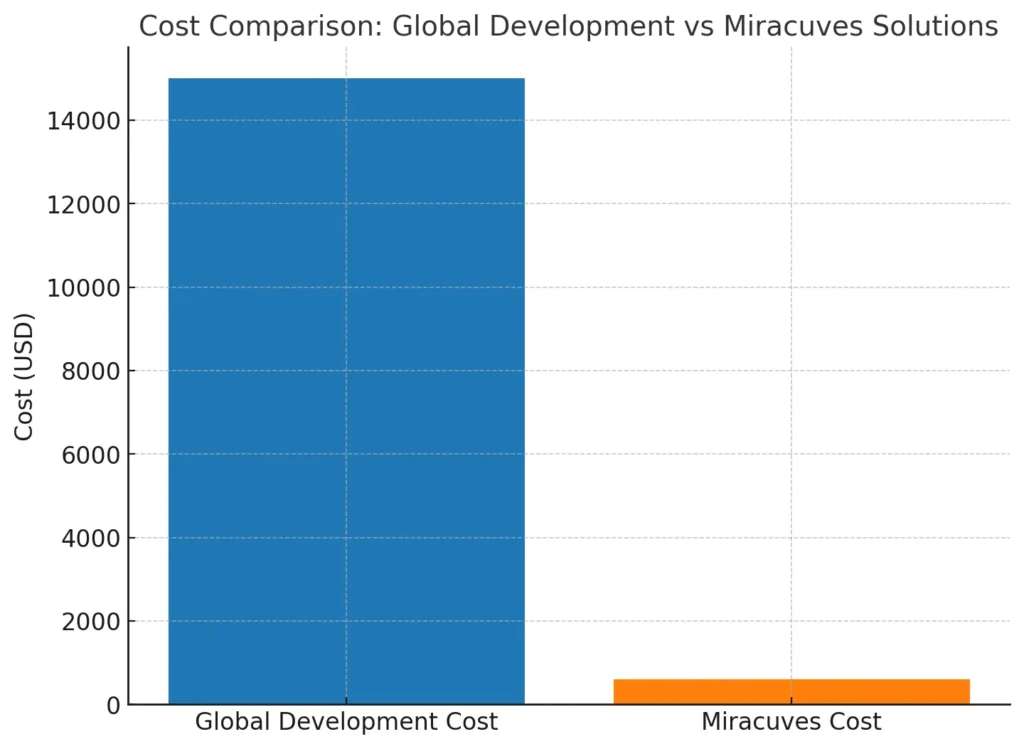
Developing a food delivery app like Zomato requires not just technical expertise but also a clear understanding of the cost and timeframe involved. These two factors are often the deciding elements for businesses when they begin a project. The good news is that while developing an app from scratch can be expensive, using pre-designed templates and ready-made solutions like those offered by Miracuves Solutions can dramatically reduce both the cost and the time it takes to get your app to market.
Global Cost for Developing a Food Delivery App
The cost of developing a full-featured food delivery app like Zomato can vary based on several factors, such as location, development team size, and the complexity of the app. On average, the global cost for a custom-built food delivery app can range from $6,000 to $30,000. This includes costs for:
- Planning and research
- Design and UI/UX development
- Backend and frontend development
- Testing and bug fixing
- Post-launch support and updates
Miracuves Solutions: A Cost-Effective Approach
With Miracuves Solutions, businesses can save up to 90% of the global cost. Miracuves offers ready-made solutions that include all the essential features, cutting the total cost down to approximately $600. This dramatic reduction is due to the reuse of proven, scalable components and templates that allow for quicker customization and deployment.
Timeframe for Development
Developing an app from scratch can take anywhere from 4 to 7 months, depending on its complexity and the features required. This includes time for wireframing, design, coding, testing, and launching.
With Miracuves Solutions, the timeframe is significantly shorter, reducing development time to just 10-14 days. This accelerated process allows businesses to enter the market faster, gaining an edge over competitors who are still in the development phase.
Breakdown of Costs and Timeframe
| Development Stage | Global Cost | Miracuves Cost | Global Timeframe | Miracuves Timeframe |
|---|---|---|---|---|
| Planning and Research | $1,000 – $2,000 | Included | 2-3 weeks | 1-2 weeks |
| Design and UI/UX | $2,000 – $5,000 | Included | 4-6 weeks | 1-2 weeks |
| Development (Frontend/Backend) | $3,000 – $15,000 | $6000 | 8-12 weeks | 5-10 days |
| Testing and Bug Fixing | $500 – $2,000 | Included | 2-3 weeks | 2-3 days |
| Deployment | $500 – $1,000 | Included | 1-2 weeks | 2-3 days |
| Total | $6,000 – $30,000 | $600 | 4-7 months | 10-14 days |
Why Choose a Cost-Effective Approach?
By opting for ready-made solutions from Miracuves, you can not only cut costs but also significantly reduce your time to market, allowing you to focus on acquiring users and growing your business. These templates are customizable, scalable, and built using industry best practices, ensuring you get a high-quality app at a fraction of the cost.
Why Trust Miracuves Solutions for Your Next Project?
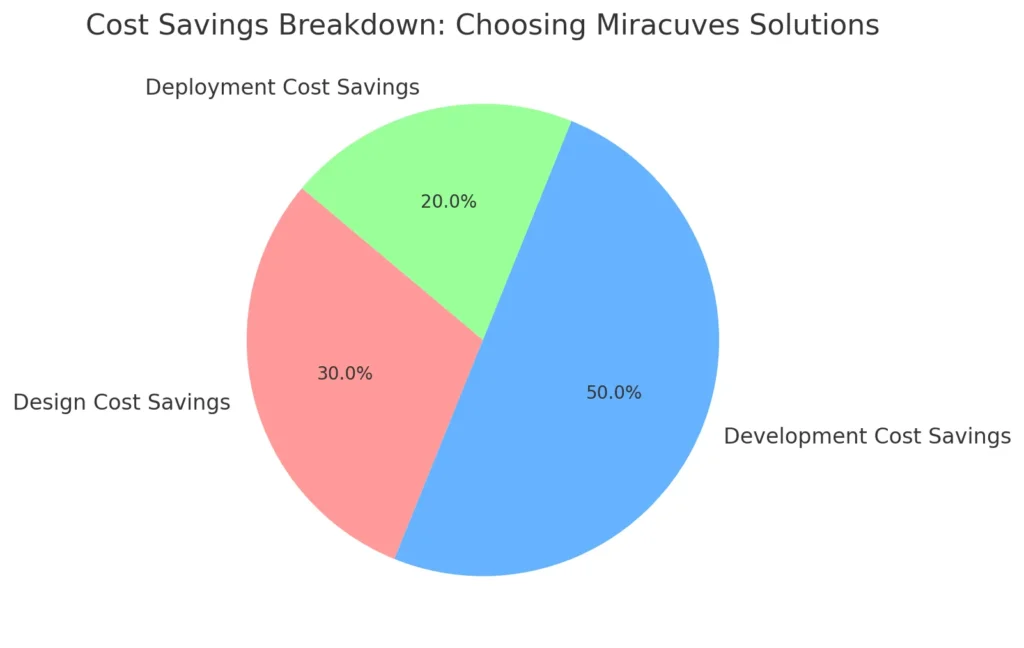
In today’s competitive landscape, building a robust and reliable food delivery app like Zomato requires not just technical expertise but a trusted development partner who understands the specific challenges of the industry. Miracuves Solutions has established itself as a reliable and innovative leader in app development, offering tailored solutions for businesses looking to launch food delivery platforms quickly and cost-effectively. Here’s why Miracuves Solutions should be your go-to choice for your next app development project:
1. Proven Track Record
- Miracuves Solutions has successfully delivered ready-made app templates and customizable solutions for numerous businesses worldwide. Their track record of launching apps in various industries, including food delivery, sets them apart. With satisfied clients and case studies to back their expertise, you can trust that your app will be in good hands.
2. Cost-Effective Solutions
- One of the major advantages of working with Miracuves is their ability to significantly reduce the cost of development. While building an app like Zomato from scratch can cost upwards of $6,000, Miracuves offers a complete solution at 10% of the global cost—for just $6000. This affordable pricing opens the door for small businesses and startups to enter the food delivery market without the burden of high development costs.
3. Fast Time to Market
- Speed is critical when it comes to launching a new app, especially in a competitive industry like food delivery. Miracuves Solutions accelerates the development process, reducing the timeframe from the typical 4-7 months for custom app builds to just 10-14 days. This rapid turnaround allows businesses to start serving customers and generating revenue much faster.
4. Customizable Templates
- While Miracuves offers ready-made solutions, these solutions are far from one-size-fits-all. Their templates are fully customizable, allowing you to tailor the app’s design, features, and functionality to meet the specific needs of your business. Whether you want to add unique features, integrate local payment gateways, or align the UI with your brand identity, Miracuves offers flexibility in customization.
5. Ongoing Support and Maintenance
- Launching an app is just the beginning. Miracuves Solutions provides ongoing support to ensure your app runs smoothly post-launch. Their team is available for troubleshooting, updates, and adding new features as your business grows. This commitment to continuous support makes them a reliable partner for long-term success.
6. Scalable and Future-Proof
- Miracuves builds apps using modern, scalable technologies, ensuring your platform can grow as your business expands. Whether you start small with an MVP or launch a full-fledged app, their solutions are designed to handle increasing user traffic and feature updates without compromising performance.
By partnering with Miracuves Solutions, you get more than just a food delivery app—you get a scalable, cost-effective, and reliable platform that sets you up for long-term success in the competitive on-demand food service industry.
Monetization Strategies for a Food Delivery App
| Monetization Strategy | Description | Typical Fee/Revenue Range |
|---|---|---|
| Commission Fees | Charge restaurants a percentage per order placed. | 15-30% per order |
| Delivery Charges | Charge customers a fee for delivery, based on distance or demand. | $1 – $5 per order or dynamic pricing |
| Subscription Models | Offer users a subscription for free delivery, discounts, or exclusive deals. | $5 – $20 per month |
| In-app Advertising | Restaurants pay for premium visibility and ad placements. | $200 – $1000 per month depending on placement |
| Featured Listings/Promotions | Paid promotions or featured listings to boost restaurant visibility. | $100 – $500 per promotion |
| In-app Purchases | Offer extra services like virtual tips, exclusive menus, or personalized experiences. | Variable (e.g., $1 – $10 per purchase) |
| White-label Solutions | License your app’s technology for other businesses to use. | Custom licensing fees, potentially $5,000+ upfront |
Monetizing a food delivery app like Zomato involves implementing multiple revenue streams to ensure long-term profitability. Whether you are developing a full-fledged app or starting with a Minimum Viable Product (MVP), integrating a range of monetization strategies can boost your revenue and improve the sustainability of your platform. Here are the most effective ways to monetize your food delivery app:
1. Commission Fees
- One of the most popular ways to generate revenue is by charging restaurants a commission on each order placed through your app. Typically, food delivery apps charge anywhere between 15-30% per order. This fee is paid by the restaurants for the convenience of reaching a broader customer base and having the delivery process managed through the app.
2. Delivery Charges
- Another straightforward monetization strategy is to charge customers a delivery fee. This fee can vary based on factors such as the distance between the restaurant and the customer, or during peak hours when demand is high. Many food delivery apps use dynamic pricing, where delivery charges increase based on demand, offering a flexible revenue model.
3. Subscription Models
- Introducing a subscription service can help create a steady revenue stream. Zomato, for instance, offers a subscription called Zomato Gold, which provides users with free deliveries, discounts, or exclusive deals for a monthly or yearly fee. A subscription model can boost user loyalty by offering ongoing value to regular customers.
4. Advertising
- In-app advertising is another powerful revenue generator. Restaurants can pay for premium visibility within the app, such as appearing at the top of search results or being featured on the homepage. This allows restaurants to reach more customers and increase their order volume, while your app benefits from additional revenue streams.
5. Featured Listings and Promotions
- You can offer restaurants the opportunity to run paid promotions or get featured listings for a fee. This could include special banners, discount offers, or event-driven promotions, making the restaurant more visible and appealing to users during specific times.
6. In-app Purchases
- While less common in food delivery apps, you can still consider offering in-app purchases like virtual tip options for drivers, exclusive restaurant menus, or personalized services (such as meal recommendations or curated experiences).
7. White-label Solutions
- If you’ve built a successful food delivery platform, you can license your technology to other companies as a white-label solution. This allows other businesses to use your app’s infrastructure for their own operations, generating revenue through licensing fees.
By combining multiple monetization strategies, you can diversify your income streams, ensuring that your app remains profitable even as the market evolves. Each strategy serves a different segment of your user base—restaurants, customers, or advertisers—giving you flexibility to scale your app and maximize its financial potential.
Launching and Marketing Your Food Delivery App
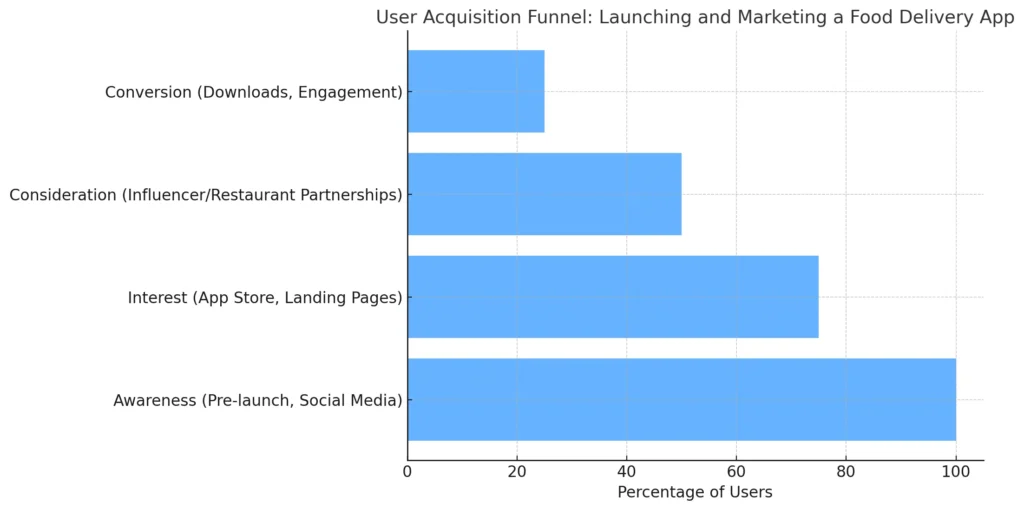
Successfully launching your food delivery app is a crucial milestone, but it’s only the beginning. To gain traction in the highly competitive food delivery market, you need a robust marketing strategy to attract users, build brand awareness, and drive downloads. Here’s a step-by-step guide on how to launch and promote your app effectively:
1. Pre-launch Preparation
- Before launching, you should create excitement around your app by building an audience. This can be done through a pre-launch campaign that includes social media teasers, email sign-ups, and exclusive early-access offers for beta users. Partnering with local influencers, food bloggers, or restaurants can help create buzz and drive anticipation.
2. App Store Optimization (ASO)
- Optimizing your app for both the Apple App Store and Google Play Store is critical to ensuring it gets discovered. Use relevant keywords like “food delivery,” “Zomato alternative,” and “restaurant delivery” in your app’s title, description, and metadata. Include high-quality screenshots and demo videos that showcase the app’s features to potential users.
- Focus on user-friendly design and ensure that your app icon is visually appealing and stands out in the crowded app store environment.
3. Leverage Social Media Marketing
- Social media platforms like Instagram, Facebook, and Twitter are ideal for promoting your app. Create engaging content that highlights the benefits of your app, such as fast delivery times, special discounts, or partnerships with popular local restaurants. Paid social media ads, especially on Facebook and Instagram, can target specific demographics such as age, location, and interests, ensuring your promotions reach the right audience.
- Utilize video marketing, sharing short clips of how your app works, behind-the-scenes of restaurant partnerships, or customer testimonials.
4. Influencer and Restaurant Partnerships
- Collaborating with local influencers, food bloggers, and restaurants can give your app a major visibility boost. Influencers can promote your app to their followers, while restaurants can offer exclusive deals available only through your platform. This win-win partnership benefits both the app and the restaurants involved, generating excitement and a sense of exclusivity for users.
5. Referral and Loyalty Programs
- Referral programs are an effective way to encourage users to spread the word about your app. Offer rewards such as discounts or free deliveries when a user refers a friend to the platform. Loyalty programs are another way to retain customers by giving them points or perks for frequent orders, turning first-time users into loyal customers.
6. Targeted Paid Ads
- Consider investing in Google Ads and paid social media campaigns to reach a larger audience. Paid advertising ensures that your app is visible to people who are actively searching for food delivery services or related keywords. You can also run geo-targeted ads to focus on users in specific areas, especially around major cities or regions where food delivery services are in high demand.
7. Engage Your Customers
- After the launch, maintain engagement with your customers through push notifications, email marketing, and in-app messages. Notify them about special deals, new restaurant partnerships, or promotions like free delivery weekends. Engaging with your customers helps build brand loyalty and encourages repeat use of the app.
By combining these marketing strategies, you can effectively promote your food delivery app and ensure a successful launch. The goal is to build brand awareness, acquire users, and create long-term engagement that drives growth.
Legal and Regulatory Considerations
Building a food delivery app like Zomato is not just about technology and marketing—it also involves complying with various legal and regulatory requirements to ensure smooth operations and avoid penalties. Each country, and even different regions, may have its own set of laws governing data privacy, food safety, and employment practices for delivery drivers. Here are the key legal aspects you should consider when developing and launching your food delivery platform:
1. Data Privacy and Protection
- Your app will collect sensitive user data, such as names, addresses, and payment information. To comply with regulations like the General Data Protection Regulation (GDPR) in Europe or the California Consumer Privacy Act (CCPA) in the U.S., you must ensure that users’ personal data is securely stored and only used for its intended purposes.
- Include a clear privacy policy in your app that explains how user data will be collected, used, and protected. Make sure to implement encryption technologies to secure transactions and protect personal data from breaches.
2. Food Safety and Health Regulations
- Since your app will partner with restaurants to deliver food, you need to ensure that these restaurants comply with local food safety and health regulations. Establish guidelines for restaurants regarding food handling, packaging, and delivery times to prevent contamination and ensure the food reaches customers safely.
- In some regions, you may be required to include nutrition information for menu items or comply with specific laws related to the sale and distribution of certain types of food.
3. Licensing and Permits
- Depending on your location, you may need to obtain specific licenses and permits to operate a food delivery service. This could include business licenses, food delivery permits, or agreements with local authorities. You should consult with legal experts to ensure you have all the necessary approvals before launching your app.
- Additionally, restaurants that partner with your app may require specific licenses to operate as part of your platform, so it’s important to verify that they are compliant with local regulations.
4. Third-Party Liability
- Since your app involves the delivery of food, you’ll need to ensure that all third parties (restaurants, delivery drivers) are covered by the appropriate insurance policies. Liability issues could arise if food arrives damaged, late, or causes harm due to improper handling. Make sure to have clear terms and conditions that limit your app’s liability in such cases and clarify the responsibilities of restaurants and delivery drivers.
5. Employment and Labor Laws
- If your app employs or contracts delivery drivers, it’s important to comply with local labor laws. This includes paying fair wages, providing benefits (where applicable), and ensuring safe working conditions. Depending on the country or region, delivery drivers might be classified as employees or independent contractors, and your legal obligations may differ based on their classification.
- Some countries have recently updated their laws regarding gig economy workers, so you’ll need to stay up-to-date with any changes in legislation that affect the classification and rights of your delivery personnel.
6. Tax Compliance
- Your app must comply with local tax laws, including collecting and remitting the correct sales tax or value-added tax (VAT) on each order. It’s important to work with a financial expert or accountant to ensure your app handles tax compliance correctly, as improper tax management can lead to costly fines or legal issues.
By understanding and complying with these legal requirements, you’ll be able to run your food delivery app smoothly, avoid legal issues, and maintain a high level of trust with your users, restaurant partners, and delivery personnel.
Read More “How to Build an App Like Shipt: A Complete Guide for Grocery Delivery Services“
Future Growth and Scalability
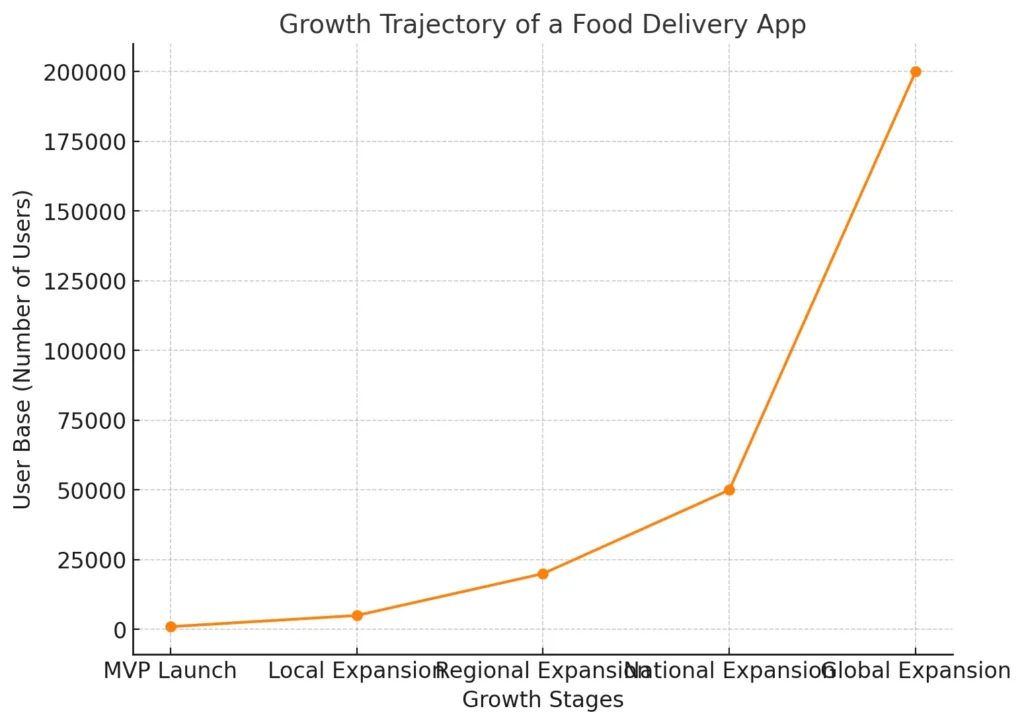
As your food delivery app gains traction, the focus shifts from launching the app to managing future growth and ensuring scalability. Scalability is the ability of your app to handle increasing numbers of users, orders, and transactions without compromising performance. Whether you’re starting small with an MVP or launching a fully-featured app, planning for future growth ensures long-term success.
Here are the key strategies to scale your app and manage growth effectively:
1. Choose Scalable Technologies
- From the very beginning, it’s important to choose a scalable tech stack. Cloud-based solutions like Amazon Web Services (AWS), Google Cloud, or Microsoft Azure provide scalable infrastructure that can automatically adjust resources to handle growing demand. As more users join your platform and orders increase, these cloud services can allocate more storage, processing power, and bandwidth without manual intervention.
2. Optimize Database Performance
- As your app grows, so does the amount of data you store. Choosing the right database solution, such as MongoDB for flexible data or PostgreSQL for structured data, ensures your app can handle increased data loads efficiently. Implementing database indexing and regular performance tuning can help maintain fast response times as more users and restaurants join the platform.
3. Enhance the Delivery Network
- Managing an efficient delivery network is key to scaling a food delivery app. Expanding your partnerships with local delivery services or hiring more delivery drivers can ensure that you meet the growing demand for fast deliveries. You can also use AI-driven algorithms to optimize delivery routes, minimize wait times, and improve the overall efficiency of your delivery operations.
4. Expand into New Markets
- Once your app has established itself in its initial market, expanding into new regions or cities is a natural next step. You can replicate the same business model in new locations while tailoring the app to local preferences and regulations. Market research and strong partnerships with local restaurants will be crucial to this phase of growth.
- Consider offering unique features for different regions, such as local cuisines or region-specific promotions to cater to the tastes of your new customers.
5. Introduce New Features
- To keep users engaged and attract new ones, you’ll need to regularly introduce new features. This could include advanced search filters, personalized recommendations, or additional payment methods. You might also expand the app’s capabilities beyond food delivery, offering services like grocery deliveries, alcohol delivery, or even partnerships with local grocery stores.
- Regularly updating your app with new features not only helps retain users but also improves user experience, encouraging more frequent usage.
6. Monitor and Improve User Experience
- As your app grows, continuously monitoring and improving the user experience is vital. Use analytics tools to track user behavior, identify pain points, and gather feedback from both customers and restaurant partners. This feedback will help you prioritize feature updates and fix any issues that could hinder growth.
- Keep an eye on app performance, loading times, and server downtimes, ensuring that as your user base grows, the app remains fast, reliable, and easy to use.
7. Data-Driven Decisions
- As your app scales, use data analytics to make informed decisions. Track key metrics like customer acquisition cost (CAC), lifetime value (LTV), and order frequency to understand your business’s health and growth potential. Data insights can help you refine your marketing strategy, optimize delivery times, and enhance the user experience.
By planning for scalability and implementing growth strategies early, your app will be well-equipped to handle increased demand, attract more users, and expand into new markets without sacrificing quality or performance.
Related Posts :-
- How to Build a Food Delivery Platform Like Amazon Fresh: From Design to Launch
- Build Your Own Food Delivery App Like DoorDash: Cost, Features, and Development Process
- Creating an On-Demand Food Service App Like Uber Eats: Key Features and Steps
Conclusion
Building a food delivery app like Zomato offers an incredible opportunity to tap into the growing on-demand food delivery market. By following a structured development process, focusing on essential features, and leveraging modern technologies, businesses can create a platform that competes with industry leaders. However, it’s not just about launching the app—it’s about ensuring scalability, smooth user experiences, and efficient delivery networks to keep customers satisfied.
Partnering with trusted solutions like Miracuves Solutions can drastically reduce development time and costs, providing a scalable, customizable platform that helps businesses enter the market quickly. With the right monetization strategies, a clear focus on customer satisfaction, and an eye on future growth, your app can thrive in this competitive space.
Whether you’re a startup looking to launch an MVP or a business aiming for rapid expansion, the tools and insights covered in this guide will help you develop, launch, and grow a successful food delivery platform that meets modern customer demands.
Curious about how a food delivery app like Zomato works?
Our customizable platform and explore how we can help you integrate real-time order tracking, delivery logistics, and restaurant discovery features.
FAQs
How much does it cost to build a food delivery app like Zomato?
You can launch a Zomato-like food delivery app for just $2,899 using Miracuves’ ready-made Zomato Clone — a complete, production-ready solution delivered within 3–6 days, helping you go live faster with all essential features for restaurants, users, and delivery partners.
What are the essential features for a Zomato-like app?
Key features include restaurant listings, order placement, real-time tracking, payment gateway integration, and ratings/reviews. These are critical to providing a smooth user experience.
How long does it take to develop a food delivery app?
You can develop and launch a complete food delivery app within just 3–6 days using Miracuves’ ready-made Food Delivery Clone. This pre-built solution eliminates months of coding and testing — offering a fully functional, scalable, and market-ready app at a fraction of the usual timeline.
Can I customize the ready-made solution?
Yes, ready-made solution from platforms like Miracuves are fully customizable. You can tailor the design, features, and functionality to suit your brand and business needs.
What monetization strategies can I implement in my app?
Monetization strategies include charging commission fees, delivery charges, offering subscription models, in-app advertising, and featured listings for restaurants.
Check out the top-rated Food delivery solutions offered by Miracuves – built for performance and scale:
- Postmates Clone Solution – Imagine one powerful platform that lets you book a stay, order your favorite meals, hail a ride, pay bills, and much more — all in a single app.
- Zomato Clone Solution – A powerful all-in-one platform for discovering top restaurants, ordering food online, reading reviews, and exploring cuisines.



